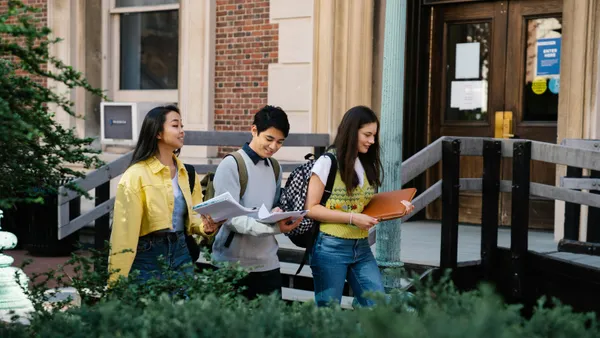Dive Brief:
- Applications to large and selective colleges and universities drove a 10% year-over-year increase in the volume of submissions sector-wide to 5.6 million as of mid-January, according to data from Common App, whose application more than 900 schools use.
- The number of individual applicants rose only 1% during that period, to around 989,000. And fewer first-generation and low-income students applied to college compared to a year ago.
- In an email to its members that included the data, Common App encouraged them to support applicants from groups disproportionately impacted by the pandemic in order to avoid the "large and inequitable" enrollment declines experienced this fall.
Dive Insight:
Earlier data from Common App showed smaller increases in total application volume, which the group suggests is because more students applied regular-decision this year than applied on early or rolling deadlines.
The latest data tracks applications through Jan. 18, which includes data from key January admissions deadlines.
Overall, students are applying to more colleges, with a 9% increase in applications submitted per student year-over-year, Common App found. For that reason, its email notes, "it is an understatement to say that yield models will be more challenged than ever this year."
But colleges won't experience that equally. Applications to member schools enrolling more than 20,000 students rose 16%, whereas those to schools enrolling fewer than 1,000 students fell 4%. Further, institutions that admit less than 50% of students tended to see bigger increases in applications than less-selective schools, Common App notes.
This is evidenced in reports of ballooning application numbers at elite colleges this fall. New York University counted more than 100,000 first-year applications this season — for around 6,500 slots. And Harvard University surpassed 57,000 submissions for its incoming class, a 42% increase, causing officials to push its decision date back by about a week, the student newspaper reported.
Such numbers are outliers, one admissions expert told Higher Ed Dive earlier this month. For instance, applications are down 20% across the State University of New York system.
Reaching first-generation students and those from historically underrepresented backgrounds also will be a challenge for colleges this year. The numbers of first-generation students and those receiving fee waivers applying with the Common Application were down by three and two percentage points, respectively. This is up from 7% declines reported in December, but the organization noted "there is still work to be done."
Financial aid requests, another leading indicator of future enrollment, were 10% below year-ago levels as of mid-January, according to data from the National College Attainment Network. Submissions from students attending high schools that serve high shares of low-income or Black and Hispanic students were down even more, by 13% and 15%, respectively.














